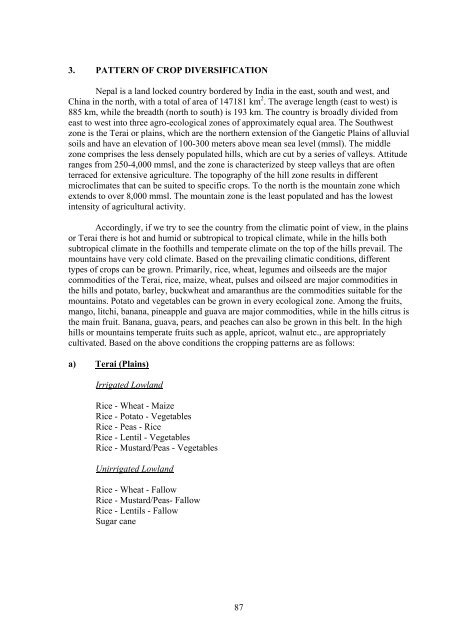Crop Diversification in the Asia-Pacific region - United Nations in ...
Crop Diversification in the Asia-Pacific region - United Nations in ...
Crop Diversification in the Asia-Pacific region - United Nations in ...
- No tags were found...
You also want an ePaper? Increase the reach of your titles
YUMPU automatically turns print PDFs into web optimized ePapers that Google loves.
3. PATTERN OF CROP DIVERSIFICATIONNepal is a land locked country bordered by India <strong>in</strong> <strong>the</strong> east, south and west, andCh<strong>in</strong>a <strong>in</strong> <strong>the</strong> north, with a total of area of 147181 km 2 . The average length (east to west) is885 km, while <strong>the</strong> breadth (north to south) is 193 km. The country is broadly divided fromeast to west <strong>in</strong>to three agro-ecological zones of approximately equal area. The Southwestzone is <strong>the</strong> Terai or pla<strong>in</strong>s, which are <strong>the</strong> nor<strong>the</strong>rn extension of <strong>the</strong> Gangetic Pla<strong>in</strong>s of alluvialsoils and have an elevation of 100-300 meters above mean sea level (mmsl). The middlezone comprises <strong>the</strong> less densely populated hills, which are cut by a series of valleys. Attituderanges from 250-4,000 mmsl, and <strong>the</strong> zone is characterized by steep valleys that are oftenterraced for extensive agriculture. The topography of <strong>the</strong> hill zone results <strong>in</strong> differentmicroclimates that can be suited to specific crops. To <strong>the</strong> north is <strong>the</strong> mounta<strong>in</strong> zone whichextends to over 8,000 mmsl. The mounta<strong>in</strong> zone is <strong>the</strong> least populated and has <strong>the</strong> lowest<strong>in</strong>tensity of agricultural activity.Accord<strong>in</strong>gly, if we try to see <strong>the</strong> country from <strong>the</strong> climatic po<strong>in</strong>t of view, <strong>in</strong> <strong>the</strong> pla<strong>in</strong>sor Terai <strong>the</strong>re is hot and humid or subtropical to tropical climate, while <strong>in</strong> <strong>the</strong> hills bothsubtropical climate <strong>in</strong> <strong>the</strong> foothills and temperate climate on <strong>the</strong> top of <strong>the</strong> hills prevail. Themounta<strong>in</strong>s have very cold climate. Based on <strong>the</strong> prevail<strong>in</strong>g climatic conditions, differenttypes of crops can be grown. Primarily, rice, wheat, legumes and oilseeds are <strong>the</strong> majorcommodities of <strong>the</strong> Terai, rice, maize, wheat, pulses and oilseed are major commodities <strong>in</strong><strong>the</strong> hills and potato, barley, buckwheat and amaranthus are <strong>the</strong> commodities suitable for <strong>the</strong>mounta<strong>in</strong>s. Potato and vegetables can be grown <strong>in</strong> every ecological zone. Among <strong>the</strong> fruits,mango, litchi, banana, p<strong>in</strong>eapple and guava are major commodities, while <strong>in</strong> <strong>the</strong> hills citrus is<strong>the</strong> ma<strong>in</strong> fruit. Banana, guava, pears, and peaches can also be grown <strong>in</strong> this belt. In <strong>the</strong> highhills or mounta<strong>in</strong>s temperate fruits such as apple, apricot, walnut etc., are appropriatelycultivated. Based on <strong>the</strong> above conditions <strong>the</strong> cropp<strong>in</strong>g patterns are as follows:a) Terai (Pla<strong>in</strong>s)Irrigated LowlandRice - Wheat - MaizeRice - Potato - VegetablesRice - Peas - RiceRice - Lentil - VegetablesRice - Mustard/Peas - VegetablesUnirrigated LowlandRice - Wheat - FallowRice - Mustard/Peas- FallowRice - Lentils - FallowSugar cane87
















